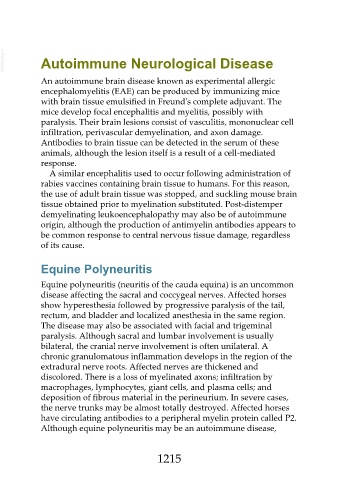Page 1215 - Veterinary Immunology, 10th Edition
P. 1215
VetBooks.ir Autoimmune Neurological Disease
An autoimmune brain disease known as experimental allergic
encephalomyelitis (EAE) can be produced by immunizing mice
with brain tissue emulsified in Freund's complete adjuvant. The
mice develop focal encephalitis and myelitis, possibly with
paralysis. Their brain lesions consist of vasculitis, mononuclear cell
infiltration, perivascular demyelination, and axon damage.
Antibodies to brain tissue can be detected in the serum of these
animals, although the lesion itself is a result of a cell-mediated
response.
A similar encephalitis used to occur following administration of
rabies vaccines containing brain tissue to humans. For this reason,
the use of adult brain tissue was stopped, and suckling mouse brain
tissue obtained prior to myelination substituted. Post-distemper
demyelinating leukoencephalopathy may also be of autoimmune
origin, although the production of antimyelin antibodies appears to
be common response to central nervous tissue damage, regardless
of its cause.
Equine Polyneuritis
Equine polyneuritis (neuritis of the cauda equina) is an uncommon
disease affecting the sacral and coccygeal nerves. Affected horses
show hyperesthesia followed by progressive paralysis of the tail,
rectum, and bladder and localized anesthesia in the same region.
The disease may also be associated with facial and trigeminal
paralysis. Although sacral and lumbar involvement is usually
bilateral, the cranial nerve involvement is often unilateral. A
chronic granulomatous inflammation develops in the region of the
extradural nerve roots. Affected nerves are thickened and
discolored. There is a loss of myelinated axons; infiltration by
macrophages, lymphocytes, giant cells, and plasma cells; and
deposition of fibrous material in the perineurium. In severe cases,
the nerve trunks may be almost totally destroyed. Affected horses
have circulating antibodies to a peripheral myelin protein called P2.
Although equine polyneuritis may be an autoimmune disease,
1215

